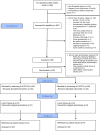Impact of rewarming rate on interleukin-6 levels in patients with shockable cardiac arrest receiving targeted temperature management at 33 °C: the ISOCRATE pilot randomized controlled trial
- PMID: 34920723
- PMCID: PMC8680374
- DOI: 10.1186/s13054-021-03842-9
Impact of rewarming rate on interleukin-6 levels in patients with shockable cardiac arrest receiving targeted temperature management at 33 °C: the ISOCRATE pilot randomized controlled trial
Abstract
Purpose: While targeted temperature management (TTM) has been recommended in patients with shockable cardiac arrest (CA) and suggested in patients with non-shockable rhythms, few data exist regarding the impact of the rewarming rate on systemic inflammation. We compared serum levels of the proinflammatory cytokine interleukin-6 (IL6) measured with two rewarming rates after TTM at 33 °C in patients with shockable out-of-hospital cardiac arrest (OHCA).
Methods: ISOCRATE was a single-center randomized controlled trial comparing rewarming at 0.50 °C/h versus 0.25 °C/h in patients coma after shockable OHCA in 2016-2020. The primary outcome was serum IL6 level 24-48 h after reaching 33 °C. Secondary outcomes included the day-90 Cerebral Performance Category (CPC) and the 48-h serum neurofilament light-chain (NF-L) level.
Results: We randomized 50 patients. The median IL6 area-under-the-curve was similar between the two groups (12,389 [7256-37,200] vs. 8859 [6825-18,088] pg/mL h; P = 0.55). No significant difference was noted in proportions of patients with favorable day-90 CPC scores (13/25 patients at 0.25 °C/h (52.0%; 95% CI 31.3-72.2%) and 13/25 patients at 0.50 °C/h (52.0%; 95% CI 31.3-72.2%; P = 0.99)). Median NF-L levels were not significantly different between the 0.25 °C/h and 0.50 °C/h groups (76.0 pg mL, [25.5-3074.0] vs. 192 pg mL, [33.6-4199.0]; P = 0.43; respectively).
Conclusion: In our RCT, rewarming from 33 °C at 0.25 °C/h, compared to 0.50 °C/h, did not decrease the serum IL6 level after shockable CA. Further RCTs are needed to better define the optimal TTM strategy for patients with CA. Trial registration ClinicalTrials.gov, NCT02555254 . Registered September 14, 2015.
Take-home message: Rewarming at a rate of 0.25 °C/h, compared to 0.50 °C, did not result in lower serum IL6 levels after achievement of hypothermia at 33 °C in patients who remained comatose after shockable cardiac arrest. No associations were found between the slower rewarming rate and day-90 functional outcomes or mortality. 140-character Tweet: Rewarming at 0.25 °C versus 0.50 °C did not decrease serum IL6 levels after hypothermia at 33 °C in patients comatose after shockable cardiac arrest.
Keywords: Cardiac arrest; Targeted temperature management; Therapeutic hypothermia.
© 2021. The Author(s).
Conflict of interest statement
All authors have completed and submitted the ICMJE Form for disclosure of potential conflicts of interest. Dr Lascarrou received lecture fees from BD and Zoll. None of the other authors have any conflicts of interest to declare.
Figures




References
-
- Lascarrou JB, Dumas F, Bougouin W, Chocron R, Beganton F, Legriel S, et al. Temporal trends in the use of targeted temperature management after cardiac arrest and association with outcome: insights from the Paris Sudden Death Expertise Centre. Crit Care. 2019;23:391. doi: 10.1186/s13054-019-2677-1. - DOI - PMC - PubMed
Publication types
MeSH terms
Substances
Associated data
LinkOut - more resources
Full Text Sources
Medical

